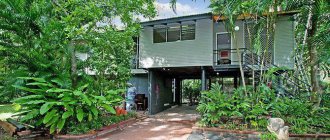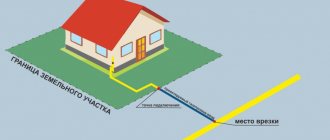By purchasing private property, we receive not only rights to it, but also obligations - this is a well-known fact. However, not every owner knows that the territory behind the fence of a private house requires increased attention from the owner, despite the fact that it does not belong to the owner by right.
In the article, we will consider what rights and obligations the owner has to the adjacent territory to the fence of a private house, who owns this territory by law, and what every owner must know in order not to face fines and other sanctions from law enforcement agencies.
What is the local area of a private house?
How to determine the size of the local area of a private house?
In accordance with the legislative framework, the described territory of a private house does not have an established definition.
However, this concept has a designation: a plot of land located near private housing construction and owned by its owner.
This type of territory is required by the owner for farming and servicing the property. You can install a fence, an additional extension, a garage, store wood, etc. on it.
landscaping
Each owner strives to create comfort and coziness both inside and outside the building. The surrounding area should be in harmony with the surrounding environment. In this regard, you should take care of its landscaping. Decorating the site with trees and shrubs allows you to advantageously decorate the area. You can use both decorative and cultural plantings, placing them in certain places. If the area is flat, then it is quite possible to create flower beds, lay out a garden, build a fountain and a gazebo, surrounding it with climbing plants. If the terrain is uneven, then you should not despair. It can also be designed in an original way.
The legislative framework
What is the local area of a private house according to the laws? At the legal level, a number of documents are presented that determine the conditions for the use of local areas. Citizens can find detailed information in:
- Constitution of the Russian Federation;
- Land and Civil Codes;
- Law “On the State Real Estate Cadastre”;
- SNiPakh;
- SanPiN;
- Technical passport and plan of the house and land plot for it.
Receiving up-to-date information will allow you to know your rights and obligations.
Procedure for marking boundaries
To determine the clear boundaries of the local area of a private house, first of all, look at the cadastral passport of the land plot. After privatization, it must indicate not only the boundaries of the private property itself, but also the adjacent area that belongs to it.
For residents of the private sector, there is no exact number of meters that the local area can occupy. In each specific case, the size of the local area of a private house may differ. To determine the boundaries of the territory that applies specifically to your private home, you need to consider the following points:
- draw a plan diagram of the site and indicate on it all the objects necessary for the use of a private house.
- Mark on your plan diagram the municipal part of the land that is adjacent to your property.
- Coordinate all controversial issues with the owners of neighboring plots claiming to use this territory.
- Provide documents to the Authorized State Bodies to establish the rights to use and own the local area.
Next we will talk about what can be considered a local area, how many meters from a private house?
Size of local area
The limits and area of the land plot near the house are indicated in the cadastral passport
Citizens should take into account that the local area of a private house may vary in size.
Moreover, the limits and area are indicated in the cadastral passport. It will record not only information about the ownership of the building, but also about the adjacent plot after privatization.
However, in many situations there are ambiguities, because the cadastral passport indicates less area of the plot than it actually is.
Fixed operating costs
All of the listed home maintenance tasks are variable costs, and the homeowner usually has time to prepare for them.
But there are also fixed costs that you have to pay monthly or annually for your own home.
Utility payments (housing and communal services)
The main fixed operating costs are utility bills. They depend on the number of square meters and the presence of meters on metering devices:
- heat;
- water;
- electricity;
- gas.
The amount of payments is, of course, individual in each case. If we take on average, for utilities (housing and communal services) of a cottage in the Moscow region with an area of 150 square meters. m., with all central communications, in the summer you will have to spend about 7-10 thousand rubles. per month, in winter - about 13-15 thousand rubles.
If the communications are not central, but autonomous (for example, your own water well, your own septic tank for sewerage), then you can save about another 30-40% on utilities.
How is land surveying carried out?
The Federal Law “On the State Real Estate Cadastre” establishes that land surveying is available only if this procedure is agreed upon by all persons who have ownership rights to the adjacent plot.
The presented meeting should be held as a gathering of interested parties. It is also possible to conduct negotiations for each participant separately.
Interested parties must be given notice at least four 30 days prior to the meeting. If they refuse to attend a meeting, they are considered to have been given notice of the meeting.
If interested parties have not expressed any objections, there are no obstacles to boundary delineation. As a result, it is necessary to create a corresponding entry in the land surveying act. After carrying out these manipulations, a notification is given. Then the owner can register the area around the house with cadastral registration.
However, carrying out this procedure does not exclude that in the future a citizen will not encounter the problem of disputes with neighbors regarding land surveying.
Studying regulations
All legal issues related to the use of land plots are regulated by the following regulations:
- Civil Code of the Russian Federation.
- Land Code of the Russian Federation.
- Federal Law “On the State Real Estate Cadastre”.
In order to dispose of a land plot, it is necessary to register it as ownership. This right can be exercised in several ways:
- Privatization, i.e. free receipt of ownership of a property from municipal property (a citizen of the Russian Federation can privatize a land plot only once).
- By purchasing.
- Inheritance by law or by will.
By registering ownership of the land, a person thereby determines the boundaries of his own territory from municipal and other lands. The above-mentioned regulations define the procedure for acquiring land as a property, as well as the basic rules for its land surveying, but none of the documents gives a clear definition of the concept of “domestic territory”.
The local area is not an exclusive attribute of private houses. Apartment buildings also have adjacent plots, and here violations of the use of these plots are much more common than in the private sector.
The Town Planning Code of the Russian Federation does not have a clearly defined meaning of the adjacent plot (shape, area, etc.). However, this regulatory act establishes maximum and minimum values for the adjacent area of apartment buildings.
According to the standards, the minimum area of a house plot is equal to the area of the parameters of the high-rise building itself, which in principle is logical. This area can be enlarged through the procedure of increasing the local area (very often the need arises due to the lack of parking spaces or children's playgrounds, which can be implemented in the local area). However, it is prohibited to unilaterally seize land without permission. As a rule, developers independently engage in expanding the territory of new houses during the construction or commissioning stage.
Who should maintain and equip it?
At the federal level, requirements for the maintenance of local areas are established. To do this, you should familiarize yourself with the following Rules and Standards for the technical operation of the housing stock:
- Cleaning the area around the house. It involves collecting household waste and transferring it to metal waste bins. They must have a maximum volume of 100 liters and be installed under a canopy. In spring and autumn, it is mandatory to paint garbage bins. Burning waste of any kind is prohibited.
- Landscaping of the site. After thorough cleaning of the area, which is completely ready for use, landscaping needs to be done. It is not advisable to plant mulberry, poplar and other trees that can clog the area.
Content
When determining boundaries, the subject of dispute may be the question of who will be responsible for maintaining the area adjacent to the structure in proper condition. Cleaning the territory is quite a pressing issue for private owners, especially in the spring-summer period and autumn. As mentioned above, the area adjacent to their buildings extends beyond the boundaries of their own allotment. In this regard, cleaning of the area should be carried out within 1.5 m from the fence.
How to register ownership of the local area?
How is the landscaping of the adjacent territory of a private house carried out? Based on the information presented, we can conclude that the interior of the site, fenced off by a fence, is the property of the owner of the house. In turn, the surrounding area mainly belongs to the municipality.
In order to have full rights to dispose of the site, it is necessary to obtain documentary evidence. It is worth considering that several people can own it at the same time.
Registration of the specified territory is available in the form of ownership or lease.
To complete this, you need to prepare a certificate of state registration of the right to the house and land. You can also provide a purchase and sale agreement with registration in the BTI.
If citizens wish to register the territory adjacent to a private house for personal use, they should contact the local government authorities.
In accordance with their decision, the site can be registered. An individual must prepare an application and a certificate confirming that the object is in an abandoned state.
Local authorities will make a decision within 18 days. The application is considered and if the answer is positive, the document will be entered into the unified register of the Unified State Register. This means that it becomes included in the appropriate accounting.
Water supply
The improvement of both the house itself and the area adjacent to it directly depends on it. In the event of an accident, a pipe break, or a valve failure, urgent repairs may be required. If a problem occurs inside a structure, it can be eliminated fairly quickly. A broken external water supply may require excavation work. This means that fences, fences, and trees can create serious obstacles. To avoid problems, it is necessary to carry out all the work on installing a water supply and irrigation system before renovating the site. At the same time, when decorating it with shrubs, lawns, trees, small architectural forms, it is necessary to take into account the location of communications so as not to damage them. If you plan to carry out vertical gardening or create a hedge, it is imperative to create a drainage system.
How to rent it out?
Is it possible to rent out the area around the house?
In accordance with the Land Code of the Russian Federation, renting the local area of a private house is also available, as is registration of ownership. To do this, you must submit an application to local authorities.
In Art. 65 of the Land Code of the Russian Federation establishes that a fee must be charged for the provision of a land plot for rent.
Its size is determined depending on the conditions of the procedure. They, in turn, are established by the Government of the Russian Federation and local governments.
However, individuals do not always receive a positive response. They may refuse in the following cases:
- There are important communication lines on the site;
- transfer of territory into ownership or lease will lead to a decrease in the width of the space on the street;
- the territory has historical and cultural significance;
- other persons claim to use the site.
If all requirements are met, the likelihood of receiving an approval increases.
conclusions
After reviewing the information presented, we conclude that the described territory may belong to the owner of the property if there are no obstacles to this.
It can be owned or leased. It is worth remembering that maintaining the site is a prerequisite for use.
To carry out procedures regarding the territory near the house, you need to contact local authorities with a prepared package of documents.
You can also learn about registration of rights to the local area by watching the video:
See also Phone numbers for consultation March 08, 2021 kasjanenko 1540
Share this post
Discussion: 2 comments
- Ivan says:
10/24/2019 at 01:20If a person wants to register the local area as his private property, will it be necessary to make changes to the cadastral documents regarding the entire plot of land on which the house is built?
Answer
- Oleg says:
05/29/2020 at 01:27
If the adjacent territory of a private household is in municipal ownership, who is responsible for maintaining it in proper condition, is the owner of the house obliged to take this upon himself?
Answer










